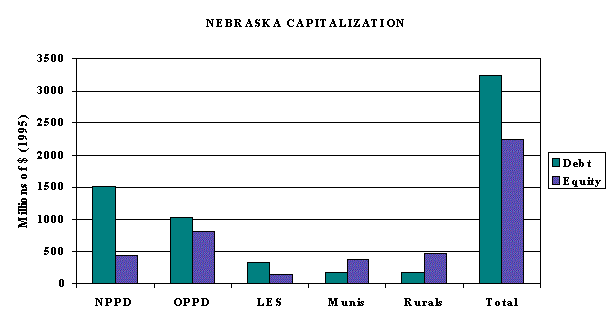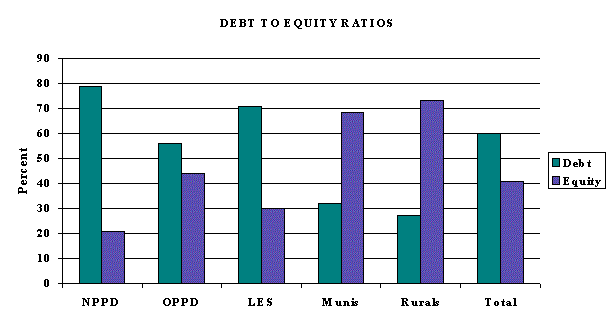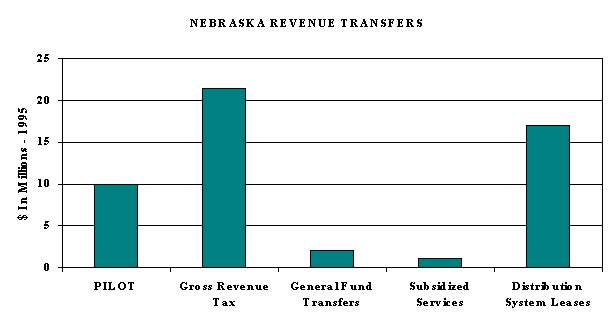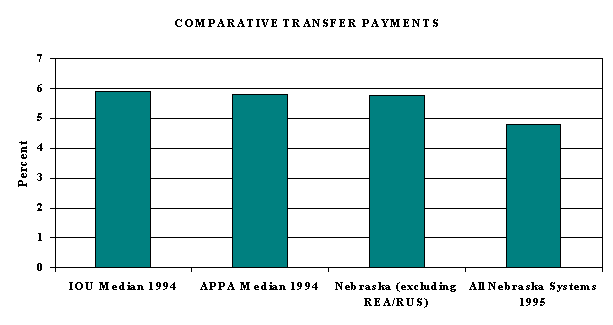| Chapter Five - FINANCE AND
TAX
5.0 INTRODUCTION While the concept of competition in the electric utility industry is not new, the prospect of increased competition at the retail level has placed additional pressure on utility financing for most electric utilities in the United States. Investor-owned utilities have responded to this new pressure by implementation of many strategies such as mergers, acquisitions, reorganizations, development of new products and services and a myriad of cost-reduction techniques. Consumer-owned utilities, including public power and cooperatives, will not be exempt from these competitive pressures as increased competition will require cost reductions and the possible need to offer other products and services to remain competitive with investor-owned utilities and other emerging competitors such as power marketers, brokers and independent power producers. While much industry attention has been focused on merger and acquisition activity of several investor-owned utilities, some public power utilities are forming alliances to share resources and mutual aid to capture some of the same benefits. Financially well-positioned electric utilities, such as many of those in Nebraska, must consider proactive steps to protect consumer-owned assets, debt holders, revenue streams and obligations to customer-owners and state/local government. An understanding of a utility’s financial and tax environment is a necessary element in preparing for possible structural changes resulting from retail competition. Chapter 5 considers the financial and tax related issues of sources of capital, indebtedness, bond resolutions, credit ratings and revenue transfers for consumer-owned utilities in Nebraska. It provides analysis and comparisons to national averages for background purposes. 5.1 SOURCE OF CAPITAL AND INDEBTEDNESS The electric utility industry is a very capital intensive industry. It is estimated that approximately 10 percent of capital investment in the United States is dedicated to the generation and delivery of electricity. Nebraska utilities have large investments in generation, transmission and distribution and other support facilities and equipment. The following table indicates the investment in plant type for reporting Nebraska electric utilities.1
In addition to the above, another $157,580,000 in plant was reported but not classified by function, plus $432,283,000 in Construction-Work-In-Progress for a total of $6,180,606,000 investment in plant. The revenue from retail electric sales was $1. 10 billion.2 This is a plant to revenue ratio of 5.62. In other words, Nebraska’s electric utilities had a fixed plant investment of $5.62 for every $1.00 of revenue in 1995. Using the net electric plant (depreciated) value of $3.8 billion of electric utility investment in Nebraska, the plant-to-revenue ratio is 3.45. The traditional sources of capital for electric utilities are stock (common and preferred), bonds and revenues. All of these capital sources are available to investor-owned utilities. Such is not the case with Nebraska’s consumer-owned electric utilities. Nebraska’s consumer-owned electric utilities only have two sources of capital available - revenues and borrowed funds - and cannot use stock as a source of capital. When a consumer-owned electric utility is formed, the only ways to fund the utility are to have the customer-owners provide all the required funds on the front end, or for the system to borrow funds for the creation and amortize this debt over the expected useful life of the facilities financed. Once the utility is up and operating, customer equity starts to accrue and can be reinvested in the system. Customer equity is created to the extent the utility has funds from revenues remaining after paying the costs of operation and maintenance, taxes, debt service and other costs of the system. This equity is then reinvested in the system in the form of new facilities or reconstruction of electric facilities to serve their customer-owners. However, because of the capital intensive nature of the electric industry and the long lives of electrical equipment, the internally generated funds are normally not adequate to satisfy all of the capital needs. Nor would it be prudent to look to internally generated funds alone for capital since it would impose too great a financial burden on current consumers to finance facilities that would be used by many consumers for long periods of time in the future. Although it is important that there be customer equity in the electric system, because of the large amount of investment required and the long life expectancy of the facilities, borrowing funds to provide part of the necessary capital is the best solution. Using borrowed capital provides a way to balance the costs with the benefits to be derived by the electric system by amortizing (repaying) the debt over a period of time that is representative of the expected lives of the facilities constructed. Debt service costs are included in consumer cost of service. At the end of 1995, Nebraska’s electric utilities had outstanding debt of $3.18 billion.3 State statutes provide the authorization for districts and municipals to incur debt to establish consumer-owned electric systems in Nebraska, pledging revenues and income from the systems to provide security for and provide repayment of the principal and interest on the debt. The specific bond resolutions of the systems include additional requirements on the issuance and repayment of debt by the systems. The bulk of the borrowed capital utilized by Nebraska’s consumer-owned electric utilities is acquired by issuing tax-exempt revenue notes and bonds in the national municipal credit markets. In addition, Nebraska’s rural electric systems have used funds borrowed from Rural Utilities Service (RUS) and National Rural Utilities Cooperative Finance Corporation (CFC). At the same time, these utilities had consumer equity (proprietary capital; reinvested earnings) of $2.17 billion.4 This equates to a debt/equity ratio of approximately 59/41. Chart 5-1 below illustrates the capitalization for Nebraska electric systems and Chart 5-2 shows the debt-to-equity ratios, The higher debt-to-equity for the three largest individuals systems reflects the dominant generating role of those utilities. Chart 5-1
Source: LR 455 Survey Chart 5-2
Source: LR 455 Survey Debt service for the year 1996 on the outstanding debt at year-end 1995 was $272.1 million. The average interest cost on outstanding debt varies by system and ranges from 4.44 percent to 6.13 percent. The average interest rate on all outstanding debt for all systems at the end of 1995 was approximately 4.94 percent. The higher debt levels of NPPD, OPPD and LES are indicative of their investment in generating plants and transmission facilities. NPPD’s debt reflects its investment to serve systems at wholesale. Conversely, the high levels of equity for municipal and rural systems correspond to the debt assumed by the larger public power districts to serve them. Minimum debt service coverage formulas are defined in the debt resolutions of the various entities. Simply stated, debt service coverage indicates the ability of a utility to pay principal and interest on their outstanding debt from operating revenues. If debt service coverage is less than one, it indicates that the utility is not able to service its debt as required by the debt resolution. Debt service coverage for 1995 reported by the Nebraska utilities ranged from 1. 1 to 5.0, with the bulk of the coverage ratios in the 1.6 to 2.0 range. These ratios are an indication of the financial strength of Nebraska’s electric utilities. The 1986 Tax Reform Act ("Act") imposed new restrictions on the use of tax-exempt debt proceeds.5 Proposed regulations for the Act were issued in 1994, but have not yet been finalized. The biggest concerns are the limitations that were placed on the use of "output facilities" (e.g., power stations and high voltage transmission facilities) that were financed with tax-exempt debt. The Act imposed "private use" limitations of 10 percent or $15 million, whichever is less, on use of tax-exempt financed output facilities. Output facilities that are debt free or that were financed with taxable debt are unrestricted. This severely restricts consumer-owned utilities with tax-exempt financed output facilities selling power and energy to other utilities that are not tax-exempt. This limits the ability to sell off surplus power and energy from a new facility in the early years of operations (prior to the time the consumer-owned utility’s load grows to use up the new power supply) and can also pose a financial hardship if an owning utility’s load does not grow as projected or a loss of existing load occurs. All of these situations could either leave a consumer-owned utility with excess power and energy it could not market due to tax restrictions, while still having to pay debt service on the debt that was issued to construct the facility, or a possible loss of its tax-exempt status if it marketed such excess to investor-owned utilities, power brokers, etc. The loss of tax-exempt status poses serious problems for both the debt issuer and the investor. The debt issuance includes a covenant that the issuer will maintain the tax-exempt status of the debt. The investor relies on that covenant and takes a lower-than-market interest rate with the expectation that income will be non-taxable. The investor does not assume, nor is there compensation for, the risk that the income will become taxable. If the income did become taxable, the investor would have recourse against the debt issuer for loss of the tax exemption. For the debt issuer, there would be a range of retroactive and future impacts from this change. These include: possible compensation to investors affected by the loss of tax exemption, higher borrowing costs and a diminished ability to issue future debt. The American Public Power Association (APPA) and the Large Public Power Council (LPPC) have been lobbying to remove the 10 percent and $15 million private use limitations. Although there appears to be some sympathy in Congress, there has not been any substantive movement at the Treasury or in Congress to ease the private use limitations. The issue of the use of tax-exempt financed facilities was further complicated by the Energy Policy Act of 1992 which requires that utilities open up their transmission systems for wholesale electricity transactions. So where the Tax Act imposes restrictions on the private use of tax-exempt financed transmission facilities, the Energy Policy Act mandates that these facilities be made available to all users. This conflict needs to be resolved on the federal level. Although not a part of the "private use" issue discussed above, rural electric cooperatives are required to conform to a tax regulation known as the 85/15 rule. If at least 85 percent of an electric cooperative’s income is collected from its members, the utility is exempt from federal income tax. If the 85 percent limit is not met, the cooperative will lose their tax exemption for a period of time. The 85/15 rule poses a problem for off-system sales and RUS borrowers who are seeking to buy out of their RUS loans because of the current treatment of the loan discount as non-member income by the Internal Revenue Service. This forces the RUS borrower to phase out RUS loans over several years, thereby increasing the risks of the buyout. The National Rural Electric Cooperative Association is supporting federal legislation that would exclude the discount from non-member income. 5.2 BOND RESOLUTIONS Bond or debt resolutions approved by the governing boards of Nebraska’s electric utilities outline the conditions under which debt can be issued. They specify how debt proceeds are to be used, how the principal and interest on the debt is to be paid, the length of the loan, debt service coverage to be provided, rate covenants, control and disposal of the facilities financed, minimum levels of expenditures that must be made to upgrade/maintain the system, as well as other provisions to protect the interests of the lender (bond holder). A debt resolution is best characterized as a loan agreement such as most businesses have with a lending institution. The lender wants assurance that the loan will be repaid, and therefore, require a certain revenue stream to ensure repayment, want to ensure that the assets financed are not disposed of or control transferred without the lender’s approval and that the assets are properly maintained so that the assets continue to produce revenues. Some bond resolutions contain cross-obligation provisions. These are most common when a group of utilities form a joint action agency to perform a common function such as providing power supply for the group of utilities. This provision obligates the remaining utilities for the obligations of any utility of the joint action agency that drops out or is unable to meet their obligations under the joint action agreement. Debt resolutions also specify compliance with applicable tax laws, especially as they relate to issues that ensure that the debt will retain the same tax status throughout the life of the debt as when it was issued. In 1994, the Securities and Exchange Commission (SEC) adopted an amendment to Rule 15c2-12 under the Securities Exchange Act of 1934, which for the first time effectively mandated ongoing disclosure obligations for issuers of municipal securities. Since the SEC lacks direct jurisdiction to require that governmental issuers file disclosure statements, the SEC, by the amendment, imposed additional requirements on brokers and dealers to make certain determinations about a municipal debt issuer before purchasing or selling securities of that issuer. This SEC requirement provides additional protection for an investor by requiring that up-to-date information on the debt issuer is readily available to the investment community. This results in most municipal debt issuers making additional disclosure in their debt offering documents, making current reports of Material Events, and filing information annually with Nationally Recognized Municipal Securities Information Repositories and state repositories, if they exist. 5.3 CREDIT RATINGS/COMPETITIVE ASSESSMENTS There are three credit rating firms ("rating agencies") that determine the credit worthiness of most municipal debt that is issued. These firms are Standard & Poor’s Rating Group (Standard & Poors), Moody’s Investor Services (Moody’s) and Fitch Investor Services (Fitch). The ratings assigned by the rating agencies impact the interest rate an issuer must pay, as well as the marketability of the debt in both primary and secondary markets. The primary focus of the rating agencies in evaluating the credit worthiness of a debt issuer is on financial, legal and economic aspects. The ability to repay the debt, the provisions of the debt resolution, the legal status of the issuer and the specific and general economic conditions in the service area of the debt issuer are all taken into consideration. To ensure a credit rating higher that would be assigned on the issuer’s credentials alone, some utilities purchase an insurance policy that guarantees payment of principal and interest on the debt in the event the issuer does not make the payments as scheduled. This type of insurance is available through firms such as Municipal Bond Insurance Association (MBIA), Federal Guarantee Insurance Corporation (FGIC) and American Municipal Bond Assurance Corporation (AMBAC). Some of the outstanding utility debt in Nebraska is insured. Insuring an issue guarantees that the debt issue will be rated in the highest category. Standard & Poor’s and Fitch also do competitive (business position) assessments of their larger municipal electric utility customers. These competitive assessments were started after the passage of the 1992 Energy Policy Act. In addition to the financial, legal and economic considerations that are part of a rating on a debt issue, these rating agencies examine other key factors to determine whether utilities have the ability to compete in a rapidly evolving electric industry with wholesale and retail competition. Standard & Poor’s focuses on Management, Operations, Competition Position and Markets, along with the traditional credit-worthiness considerations when making a competitive assessment. Standard & Poor’s uses a scale of 1 to 5, with 1 being the strongest. Standard & Poor’s has assigned a 1 to LES, a 2 to OPPD and a 3 to NPPD and Tri-State. Fitch also uses a scale from 1 to 5 with 1 being the most competitive. Fitch has assigned a competitive index of 2.13 to LES and 2.75 to Tri-State.6 All of these assessments indicate that the Nebraska utilities reviewed have good competitive characteristics, Investors in municipal bonds and notes issued by Nebraska utilities rely on the credit ratings and competitive assessments published by the credit rating firms. There is no guarantee that these ratings or assessments will not change over time. The advent of competition could have positive or negative implications for the Nebraska systems. This would change the risk for the holder of the debt. The most negative consequence would be a default on principal and interest payments. The larger electric systems in Nebraska have their debt rated on an ongoing basis. This debt includes revenue bonds, revenue notes and commercial paper. The current ratings on Nebraska’s electric utility debt indicate an overall strong financial condition. There have not been my major changes in the ratings over the last several years and there are no major rating changes contemplated in the near future. 5.4 REVENUE TRANSFERS When a governmental unit (municipal or public power district) operates an enterprise business such as an electric utility, state and local governments utilize various alternate means to obtain tax replacement funds from these non-taxable entities. For example, after Consumers Public Power District was formed in 1939, the Enabling Act was amended to provide for payment in lieu of taxes to be made by any district acquiring property which had previously been taxed. The alternate means used to collect these tax replacement funds in Nebraska consist of the following:
All electric utilities operating in Nebraska make payments to the state or local governments in one or several of the forms shown above. Payments in lieu-of-taxes and gross revenue tax are set by state statute, whereas general fund transfers and free/subsidized services policies are set at the local level. In addition to the types of payments shown above, rural cooperatives also pay property taxes. Some municipalities lease their local distribution systems to public power districts and electric cooperatives. NPPD, Loup, Norris and certain Nebraska G&T and Tri-State members lease municipal distribution systems. Although these lease payments do not constitute a tax equivalent, they are similar to franchise fees. These lease payments represent a major expense to the leasing public power system and a major benefit to the municipalities that lease out their local distribution systems. Chart 5-3
Source: LR 455 Survey Nebraska’s consumer-owned electric utilities contributed $51.257 million, exclusive of sales and use tax payments, primarily to local governments in 1995 as follows and as illustrated in Chart 5-3 above. The dollar amounts for the individual categories:7
Total retail electric energy revenues in Nebraska for 1995 were $1.102 billion. Comparing these revenues to the total transfer payments in 1995 totaling $51 .3 million produces an average tax equivalent rate for all Nebraska systems of 4.7 percent.8 Because most of the revenues of the REA/RUS systems come from rural areas, the gross revenue tax (calculated as 5 percent of the gross revenue derived from retail sales of electricity within incorporated cities and villages) produces a very small amount of tax replacement revenue for local governments. Excluding the REA/RUS systems, the average tax equivalent rate for Nebraska systems is 5.7 percent. This compares to the American Public Power Association (APPA) median rate for all consumer-owned utilities of 5.8 percent and the APPA median rate for the West North Central Region (which includes Nebraska) of 5.3 percent.9 The comparable median rate for private investor-owned utility is 5.9 percent for 1994.10 This is indicated in Chart 5-4 below. Chart 5-4
Source: LR 455 Survey, EEI, APPA (See Chapter Notes 9,10). There has been speculation that the relatively low electric rates enjoyed by Nebraska consumers is primarily the result of a lower average tax equivalent paid by the Nebraska systems. However, if all Nebraska systems made transfer payments in 1995 equal in percent to the tax paid by private investor-owned utilities as shown above (e.g., 5.9 percent), the average impact on the cost of electricity in Nebraska would be minimal. The difference between the investor-owned utility rate of 5.9 percent and the Nebraska average rate of 4.7 percent when applied to the Nebraska retail electric energy revenues in 1995 ($1.102 billion) is $13.761 million or 1.25 percent.11 5.5 SUMMARY AND EMERGING ISSUES The elements of revenue transfer, sources of capital and indebtedness, bond resolutions and credit ratings/competitive assessments are parameters for use by financial analysts internal and external to a particular utility organization. As noted above, Nebraska’s three largest utilities that are carrying the bulk of the industry debt have been judged to have good competitive characteristics. There is wide variance between the diverse systems in debt service coverage and IRS restrictions, however, and competitive pressure could have different impacts on individual systems. The following is a fist of financial and tax-related emerging issues that wise from the prospect of competitive retail market conditions:
Chapter Two - STRUCTURE AND GOVERNANCE Chapter Three - STATUTORY AND REGULATORY OVERSIGHT Chapter Four - PLANNING AND OPERATIONS Chapter Five - FINANCE AND TAX Chapter Six - DEREGULATION AND RESTRUCTURING The Central Nebraska Public Power and
Irrigation District
|
|||||||||||||||||||||




